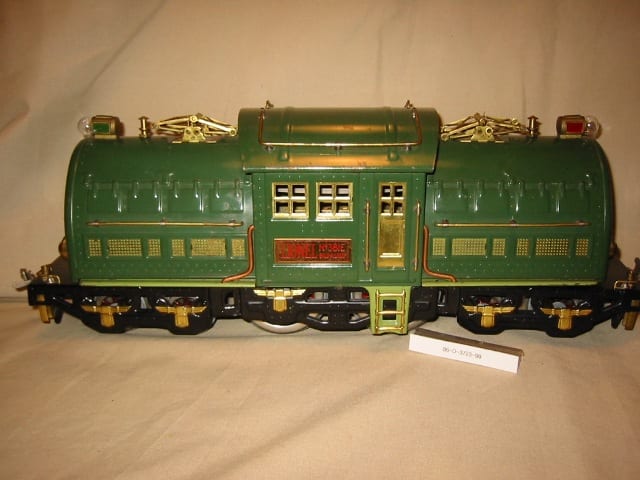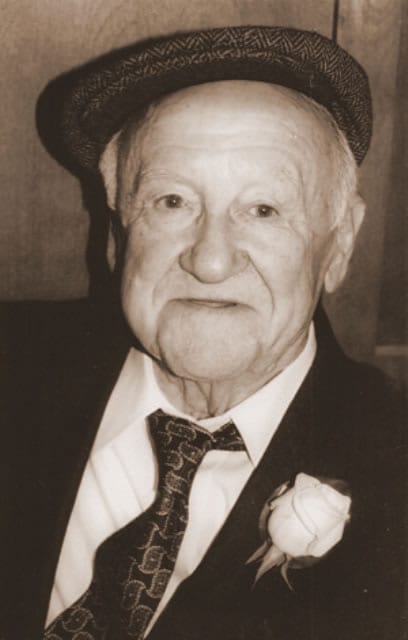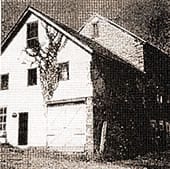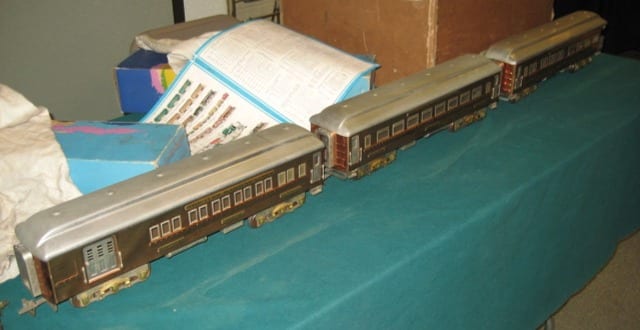Don Laspaluto, CM-7, and a Wealth of Knowledge
By Carol Redman McGinnis, 95-41066Spring 2018
In August and September of 2010, Paul Stimmler, of the National Toy Train Library (NTTL) Committee, interviewed Don Laspaluto, CM-7. As background on the signifigance of this number, the official name of TCA was adopted at a meeting in October 1954. The official adoption of the bylaws and creation of the newsletter (now known as the National Headquarters News) was deferred until other known collectors could signify their intention of becoming members. December 10, 1954 was set as the deadline. Of the known collectors, 68 then became “Founding” Charter Members. Thus Don was Charter Member #7, an impressive feat in and of itself, At the time of these interviews he was 95 years old, very alert and crisp in his responses with a powerful memory for specifics.
Don was President of TCA from 1966-1967. He was a renowned early collector of all makes of interesting and rare American made tinplate toy trains. He especially liked Ives Trains including their sets, signals, catalogs and advertising. Among his many talents he would reproduce early and rare catalogs from his own collection.
And now, to the interviews:
Paul: Do you recall your first electric or wind-up toy train as a child?
Don: As a matter of fact I do. It was a Lionel electric #248 locomotive with a bright orange passenger set. Lionel was famous for its bright colors. I got it for Christmas in 1927 when I was about 12 years old. My dad was a carpenter and built cabinets so we didn’t have much money. Before that Christmas I had inexpensive little wooden pull trains. I was told that I had to share this train with my two older brothers, but that worked out fine. They were teenagers and were more interested in girls, so I had the Lionel train set pretty much to myself!
Paul: How did you get started collecting toy trains?
Don: I had an early interest and somehow got introduced to a fellow named Ellis in Germantown, outside of Philadelphia. This was the late 1940s and he had a store and also published a mailing list of antique toys and trains. I was very curious so I decided to visit his store and was highly impressed. He had such a variety.
Paul: But what brought you to Germantown?
Don: As an adult I made my living traveling around the country, mostly up and down the East Coast. I was a newspaper comic strip syndication salesman for United Feature Syndicate. Among the comic strips you may recall “Peanuts,” “Garfield,” “Mutt and Jeff,” and “Superman.” After I finished work for the day I would visit places that were advertised in hobby books, or visit with people that others had told me about.
Paul: What directed you to TCA?
Don: I think that is was Mr. Ellis in Germantown who told me about TCA, Ed Alexander, Bill Krames, and Lou Redman. So, I decided to visit Ed Alexander’s barn in Yardley, PA where TCA got its start. What an amazing place. I still recall my first visit there which would have been in 1955 or 1956. Ed had whitewashed the walls of the barn to better display his collection. This was on a real farm and there were all kinds of farm animals around the place. Later he took me down the road to his house which was what you would call a real “bachelor pad.” It was full of interesting collectibles of all kinds.
Paul: And you met Lou Redman there early on, as well?
Don: Oh yes. He was the most energetic and fun guy I ever met, before or since, in my entire life. Lou conducted the early TCA auctions, kept us in touch with one another through newsletters, updates, and telephone calls. He introduced me to other collectors and gave me leads on interesting toy trains and related stuff that was for sale. He was so funny, at times dressing up in clown costumes and entertaining us. I would have to say that it was his high energy that propelled this organization forward in its earliest days. Lou, Bill Krames, and Ed Alexander were clearly the 3 key players.
Paul: What contact, if any, did you have with famed toy train writer Lou Hertz?
Don: Lou H and I lived near one another. He was in Scarsdale, NY and I was in Queens. We both had our strongest collecting interest in Ives trains. While he never joined TCA he always seemed to be involved with toy train shows and other activities. I recognized his phenomenal knowledge about Ives and I would call him from time to time to research information on Ives. He was always forthcoming and helpful. I liked him a lot.
Paul: Speaking of Ives, did you ever get to visit the IVES Factory in Bridgeport?
Don: Yes, a few times, including when the bronze plaque that is now in the TCA National Toy Train Museum was dedicated and installed on the old IVES factory building. The Mayor of Bridgeport was there that day along with “Doc Robbie” Robinson and Lou Hertz. There were also members of the Ives family including Royal Ives, Harry’s surviving brother, and Alice Ives, Harry’s sister. I think former TCA President John Marron was there that day, too. I got the autograph of Royal and Alice on an Ives reprint 1931 catalog!
Paul: Do you still have that catalog?
Don: Yes. I have sold most of my trains, accessories, and paper collections 30 years ago when I retired. That was also when I moved from Queen Village to Middleburgh, NY which is near Albany. The old neighborhood was becoming dangerous. We were burglarized twice and my wife and I decided to move to the countryside where my sons and my daughter were living. I have another son living in North Carolina.
Paul: You reprinted some very rare and early toy train catalogs from your personal collection including ones from the earliest years of Lionel. Those have been very valuable to us at the NTTL and to the general membership. Do you have any interesting anecdotes associated with Lionel or its founder Mr. Cohen?
Don: Actually I do. I usually went to the Lionel headquarters with a sample after I had the catalog reprints in from the printer. I requested Lionel founder and President Mr. Cohen to sign it. He would cheerfully sign them for me and sometime he wrote “Good job” on them. I found him to be a very nice man and he was reportedly very kind to the employees. One employee I remember particularly well from those days was Irving Shull who was a top right hand assistant to Mr. Cowen.
Paul: What about Shull resonated with you?
Don: From what I could tell he was very effective as Mr. Cowen’s “get-it-done” person. On one occasion I brought in an unusual toy train or unknown manufacture where the motor was in the tender. It had a drive shaft on a 45 degree angle down to the axle. I showed it to Mr. Cowen who said “We could do that!” He then called in Shull and said “Look into this Irv.”
Paul: Would you tell us what was your most interesting and valuable toy train piece?
Don: Without question it was the Ives “Prosperity Special,” which was the copper-plated standard gauge locomotive and tender. And what a beauty it was.
Photos of the Prosperity Special courtesy of the Ives Train Society. Notice the original boxes and the original felt wrapping paper that protects the copper/nickel finish. More information can be viewed at http://www.ivestrains.org/webonly/prosperity/prosperity.htm.
Paul: How did you acquire it?
Don: It came from a trade with Ward Kimball. Ward really wanted a Lionel #381 which I had, so he offered me the “Prosperity Special” in trade. I was very pleased with that transaction.

Lionel 381e, red mfg. board
Paul: Are there any interesting toy train stories from your collecting years or toy trains that struck your particular fancy?
Don: You bet. I was the original collector-owner of both of the so called “big-brute,” the Lionel standard gauge green #381 that were sold from the Lionel showroom shortly after J.L. Cowen sold the company to his grandnephew Roy Cohn and that business syndicate of his. At that point the new top operations people at the new Lionel ordered that all the early trains from the Lionel Historic display in the New York City showroom were to be sold. I was contacted, given a price, and was surprised that Lou Hertz hadn’t already purchased it. So I asked them if Lou was interested. As it turns out he wasn’t. I had to bring cash and gathered the money with the help of a friend.
Paul: Our readers, and I, would surely be interested to know what you paid for them.
Don: At that time, part of the formal terms of the transaction was that Lionel asked that I would never reveal the price. And so, to this day some 50+ years later I intend to keep my word.
Paul: You concentrated your collecting on both Lionel and Ives. You certainly owned some really rare Lionel pieces and have told me that the colors of Lionel (was what) you found very attractive. But what caused you to concentrate on Ives?
Don: Three things. I was strongly influenced by Lou Hertz’s book, Messrs Ives of Bridgeport. I found Ives very appealing, and I developed a long term personal friendship with Lou Hertz, whose own main interest and expertise was clearly Ives.
Paul: It’s interesting you would say that about Lou Hertz because in the 1970s there was an “American Flyer Collectors Club” founded by Frank Hare and others. In one of their first publications they interviewed Hertz and after a few comments about the Coleman’s and their ownership and management of American Flyer I noted that he spent most of his interview talking about Ives!
Looking back, any regrets by the way of toy trains that you wish now that you did not sell?
Don: Absolutely. I regret not donating those two big Lionel 381s we just talked about to the TCA Museum. I sold one to famed collector LaRue Shempp in Williamsport, PA and the other to a dealer in NY who plated it. Of the two I always believed that the smaller one was the more realistic and attractive in its proportion.
Paul: Don, I am currently doing some research on our first TCA President, Burton Logan (1894-1964). Did you know him, and if so, what could you tell me about him?
Don: I met him a few times at meetings at Bill Krames’ house, but I didn’t know some of the personal details of his life particularly well.
PAUL’S NOTES: Burton Logan was born in Illinois. His father was a fireman and the family moved to Kansas when Burton was quite young. His youth saw a variety of unskilled jobs including chauffeur for a real estate firm, gas station attendant, and movie theater manager. Yet, by 1935, he was amassing a huge collection of very early, very rare, and very valuable 2 gauge trains. These included Howard, Carlisle and Finch, Knapp, Elektoy, Voltamp. His residences were listed as Clarks Summit, Pennsylvania and at the Edaville Railroad in South Carver, Massachusetts. He and his wife, Lena, had one daughter and four granddaughters.
Paul: I ask because I’m curious as to what prompted the first 68 members listed in that very first TCA directory (published by Lou Redman in January 1955) to elect him unanimously as first President? I note that at 60 years of age in 1954 he was chronologically older than most of you, who were mainly in your 30s then.
Don: That I can answer. As you note he was considerably older than the rest of us. But in addition he had an expert and wide knowledge of toy trains, had a huge collection of really valuable and rare tinplate toy trains including early 2 gauge and had a wonderful, engaging, friendly, and outgoing personality. He was a really likeable person who was a natural born leader to my way of thinking.
Paul: Thanks for the interesting history, Don!
Copyright 2010, Paul T. Stimmler
Editors Note: “Oral History” is a maddeningly imprecise term. It is often used to refer to “formal, rehearsed accounts of the past presented by culturally sanctioned tradition-bearers”. It is also described as “printed compilations of stories told about past times and present experiences” and finally “recorded interviews with individuals deemed to have an important story to tell.” (historymatters.gmu.edu/mse/oral/what.html)
Each of these uses of the term has certain validity. Unquestionably, most people throughout history have learned about the past through the spoken word. Moreover, for generations history-conscious individuals have preserved others’ firsthand accounts of the past for the record, often precisely at the moment when the historical actors themselves, and with them their memories, were about to pass from the scene. (http://historymatters.gmu.edu/mse/oral/what.html)
What becomes important to TCA in this is that we have a wealth of information that, if not recorded in some manner, will be lost to those who cherish it most. That being said the NTTL set forth several years ago to record Oral Histories of well-known members, businessmen, and toy train dignitaries. The compilations of this project reside at the NTTL in Strasburg.
It is now time for them to be shared. e*Train is the venue to be utilized. Enjoy!









